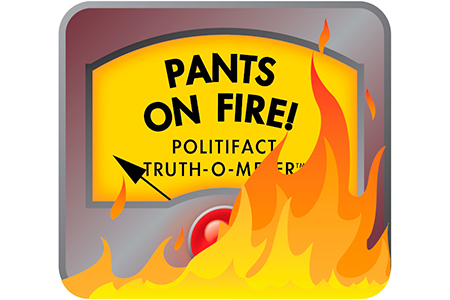To show that his administration has been fast and effective in its response to the new coronavirus, President Donald Trump claimed that anybody who wants to get tested for the respiratory disease caused by the virus can do so.
“Anybody that wants a test can get a test. That’s what the bottom line is,” Trump told reporters March 6 during a visit to the Centers for Disease Control and Prevention in Atlanta.
Moments later, Trump added that anybody who needs a test gets one.
“But as of right now and yesterday, anybody that needs a test — that’s the important thing — and the tests are all perfect, like the letter was perfect. The transcription was perfect, right? This was not as perfect as that, but pretty good,” Trump said. (Trump’s mention of “the letter” and “transcription” was a reference to his recent impeachment.)
As large public gatherings around the United States are being canceled and some colleges are suspending in-person classes to avoid the spread of the disease, PolitiFact decided to fact-check Trump on his “bottom line” assessment that anybody who wants a test will get one.
He’s wrong. Current supply of the test is limited, and it is clinicians who decide whether a patient meets criteria to warrant testing. Testing is not as easy as just calling your doctor or pharmacy, saying you want to be tested for COVID-19 and getting it done.
“Unfortunately, it’s not that simple yet,” said Christopher Mores, a professor of global health at George Washington University.
There is greater availability of tests, but the number of labs involved in the testing process is still limited, Mores said. Testing is expected to increase as more commercial labs participate, but even they have limits in the number of patients that can be tested daily, Mores said.
PolitiFact found news reports of people who wanted to get tested and couldn’t, or of hindrances in the testing process. Here’s a sample:
- CBS Miami reported March 2 that a woman who had returned from Italy was told at a hospital that she likely had COVID-19 but was refused a test. The woman, not named by CBS Miami, said one of the reasons she wasn’t tested for the new coronavirus was because she was not in a high-risk category, since she was in her 30s and otherwise healthy. (She tested positive for earlier coronavirus strains, coronavirus 229E and NL63, according to CBS Miami.) The hospital and state health department did not comment on the case.
- Texas Tribune reported March 11 that Texas’ largest public health lab can do a maximum of 26 tests per day. Doctors and hospitals did not yet have the capability to do tests on their own premises. (An NPR report indicates this issue is not limited to Texas.)
- The Mercury News reported that the president of the California Academy of Family Physicians said no one had been trained to do the test. (The story published March 7 and was updated March 10.)
CDC: Health Care Providers Decide Who Gets Tested For COVID-19
The CDC on its website said that if people come in close contact with someone who has the respiratory disease and they develop symptoms, they should call their health care provider.
“They will decide whether you need to be tested, but keep in mind that there is no treatment for COVID-19, and people who are mildly ill are able to isolate at home,” the federal health agency said.
Elsewhere on its website, the CDC said, “Clinicians should use their judgment to determine if a patient has signs and symptoms compatible with COVID-19 and whether the patient should be tested.”
Factors to consider for testing include whether individuals were in close contact with a confirmed or suspected COVID-19 patient within 14 days of symptoms, or if they traveled from affected geographic areas within 14 days of symptom onset.
Clinicians who want to test a patient should work with local and state health departments to coordinate testing through public health labs, CDC said. That process could be delayed if the labs are running at capacity.
Limited Number Of Tests
The CDC is typically the first one to develop a diagnostic test because they have access before others to clinical specimens and viral samples. The CDC test then becomes the basis for tests developed by others. But there were manufacturing problems with the CDC test at first.
Trump administration officials have provided conflicting information regarding how many people can be tested. Stephen Hahn, the commissioner of the Food and Drug Administration, acknowledged the confusion on March 7.
Hahn said that production issues were eventually resolved by a third-party manufacturer. That manufacturer is producing tests for state public health labs, academic medical centers, community hospitals and other nonpublic health labs.
The CDC has shipped tests to public health laboratories to test about 75,000 people, Hahn said. Additionally, 1.1 million tests were shipped to nonpublic health labs, and around 1 million more tests were close to being shipped, he said.
But the number of tests shipped doesn’t equal the number of people that can be tested. For instance, 2.1 million tests would roughly translate to testing for 850,000 Americans, according to Hahn.
Manufacturers plan to scale up production so they can ship 4 million more tests by mid-March, Hahn said, and large commercial and academic labs are also expected to make more tests.
Our Ruling
Trump said, “Anybody that wants a test can get a test.”
This is wrong. Health care providers make the call on who gets tested, based on recommendations from the CDC. There’s an increase in the number of tests being manufactured, but an increase in the availability of tests does not mean that “anybody that wants a test can get a test.”
Trump’s statement is inaccurate and a gross oversimplification of the facts. We rate it Pants on Fire.
This story was produced by Kaiser Health News, an editorially independent program of the Kaiser Family Foundation.
